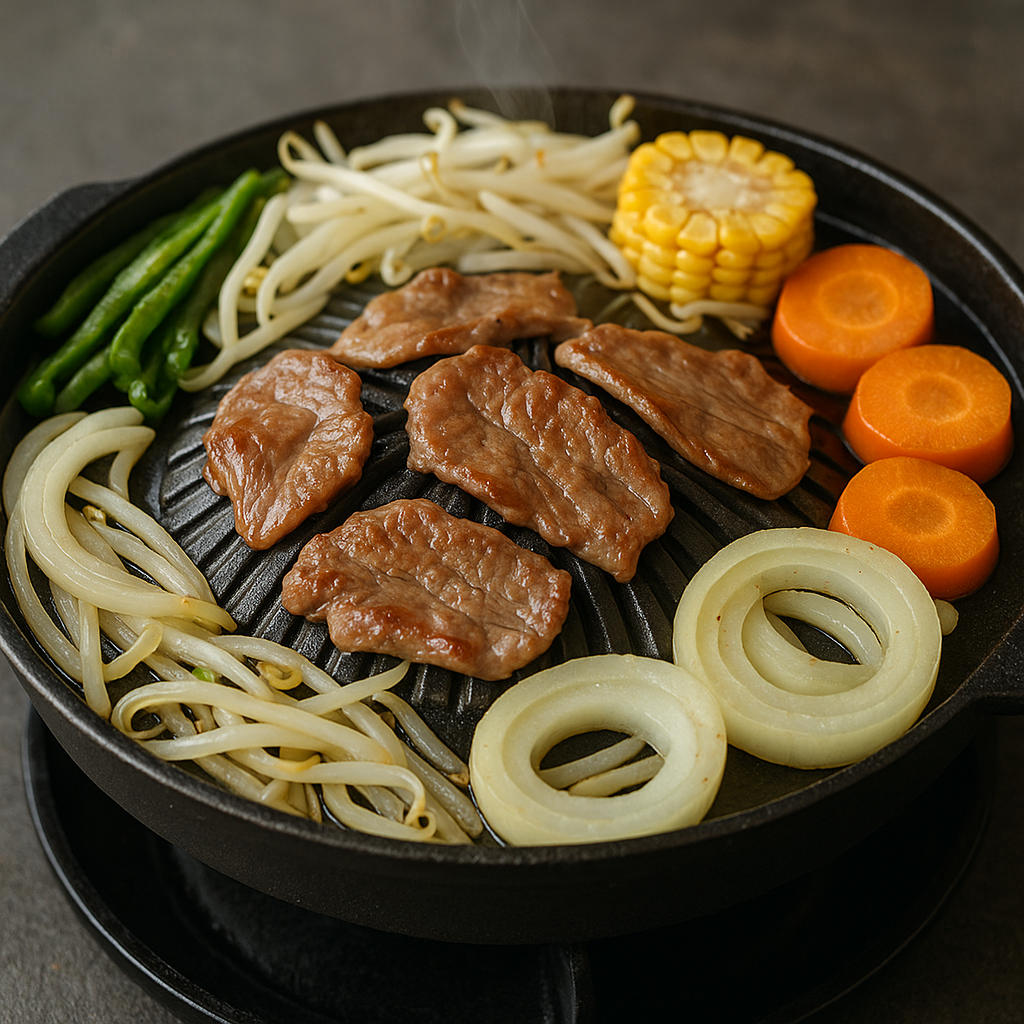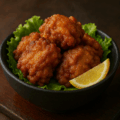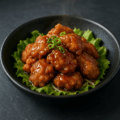ジンギスカンの特徴
北海道を代表する羊肉料理
ジンギスカンは、鉄鍋を使って羊肉と野菜を焼く北海道の郷土料理です。羊肉独特の風味と、タレや塩で味わうスタイルが特徴です。
鉄鍋の工夫
中央が盛り上がった専用のジンギスカン鍋を使用し、肉から流れる脂で周囲の野菜を焼き上げる仕組みになっています。
多彩な味わい方
タレに漬け込んだ「味付けジンギスカン」と、焼きながらタレにつけて食べる「生肉ジンギスカン」があり、家庭や店によって食べ方が異なります。
ジンギスカンのレシピ
材料(4人分)
- ラム肉またはマトン肉(スライス) … 500g
- キャベツ … 1/4玉
- トウモロコシ…1本
- もやし … 1袋
- 玉ねぎ … 1個
- 人参 … 1/2本
- ピーマン … 1個
- タレ(市販または自家製) … 適量
作り方
- 野菜を食べやすい大きさに切る。
- ジンギスカン鍋を熱し、中央に肉を並べる。
- 周囲に野菜を配置し、肉から出る脂で焼きながら炒める。
- タレを絡めながら好みの加減で焼き、熱々をいただく。
シェフのワンポイントアドバイス
ラム肉は臭みが少なく初心者向け、マトンは濃厚な味わいで食べ応えがあります。
タレににんにくや生姜を加えると風味が増し、ご飯やビールと相性抜群です。
ホットプレートで焼く場合には肉と野菜を隣り合わせにして配置すると似た味わいになります。
ジンギスカンの栄養価(1人分の目安)
- エネルギー:約450〜550 kcal
- たんぱく質:30〜35 g
- 脂質:20〜25 g
- 炭水化物:20〜30 g(野菜由来)
- 鉄分・亜鉛(羊肉由来)
- ビタミンB群(特にB12が豊富)
- L-カルニチン:脂肪燃焼を助ける栄養素
高たんぱく・高ミネラルで、スタミナ料理としても人気です。
ジンギスカンの歴史
名前の由来
モンゴルの英雄チンギス・ハンに由来し、羊肉を食べる文化から名付けられたといわれます。
北海道での普及
昭和初期、開拓民の栄養源として羊の飼育が奨励され、羊肉料理としてジンギスカンが広まりました。
郷土料理としての定着
戦後、北海道全域で食べられるようになり、家庭やビアガーデン、観光地でも提供される代表的な郷土料理になりました。
English Version
Features of Jingisukan
A Representative Lamb Dish of Hokkaido
Jingisukan is a traditional Hokkaido dish where lamb and vegetables are grilled on a special iron pan. The unique flavor of lamb, combined with dipping sauces or salt, makes it distinctive.
Special Grilling Pan
A dome-shaped Jingisukan pan is used, where the meat is placed in the center, and the rendered fat flows down to cook the vegetables arranged around it.
Various Ways to Enjoy
There are two main styles: “marinated Jingisukan,” where the lamb is seasoned beforehand, and “fresh Jingisukan,” where the meat is grilled plain and dipped into sauce. The style varies by household and restaurant.
Recipe
Ingredients (for 4 servings)
- Lamb or mutton (sliced) … 500 g
- Cabbage … 1/4 head
- Corn … 1 ear
- Bean sprouts … 1 bag
- Onion … 1
- Carrot … 1/2
- Green pepper … 1
- Sauce (store-bought or homemade) … as needed
Instructions
- Cut the vegetables into bite-sized pieces.
- Heat the Jingisukan pan and arrange the meat in the center.
- Place the vegetables around the edges and cook them with the meat’s rendered fat.
- Cook to your liking while mixing with the sauce, and enjoy hot.
Chef’s Tip
Lamb has a milder flavor and is good for beginners, while mutton is richer and more robust. Adding garlic or ginger to the sauce enhances the flavor and pairs well with rice or beer. If using a hot plate, arrange meat and vegetables side by side to recreate the traditional flavor.
Nutritional Value (per serving, approx.)
- Calories: 450–550 kcal
- Protein: 30–35 g
- Fat: 20–25 g
- Carbohydrates: 20–30 g (mainly from vegetables)
- Iron and zinc (from lamb)
- B vitamins (especially B12)
- L-carnitine: supports fat metabolism
Rich in protein and minerals, Jingisukan is considered a stamina-boosting dish.
Historical Background
Origin of the Name
The name comes from Genghis Khan, the Mongolian hero, symbolizing the tradition of eating lamb in nomadic cultures.
Spread in Hokkaido
In the early Showa era, lamb was promoted as a food source for settlers, leading to the spread of Jingisukan as a lamb dish.
Established as a Regional Cuisine
After World War II, it became popular throughout Hokkaido and is now enjoyed at home, in beer gardens, and at tourist spots as one of Hokkaido’s representative dishes.



何でも質問してください!